Related Research Articles

Sonar is a technique that uses sound propagation to navigate, measure distances (ranging), communicate with or detect objects on or under the surface of the water, such as other vessels. Two types of technology share the name "sonar": passive sonar is essentially listening for the sound made by vessels; active sonar is emitting pulses of sounds and listening for echoes. Sonar may be used as a means of acoustic location and of measurement of the echo characteristics of "targets" in the water. Acoustic location in air was used before the introduction of radar. Sonar may also be used for robot navigation, and SODAR is used for atmospheric investigations. The term sonar is also used for the equipment used to generate and receive the sound. The acoustic frequencies used in sonar systems vary from very low (infrasonic) to extremely high (ultrasonic). The study of underwater sound is known as underwater acoustics or hydroacoustics.
Poromechanics is a branch of physics and specifically continuum mechanics and acoustics that studies the behaviour of fluid-saturated porous media. A porous medium or a porous material is a solid permeated by an interconnected network of pores (voids) filled with a fluid. Usually both solid matrix and the pore network are assumed to be continuous, so as to form two interpenetrating continua such as in a sponge. Many natural substances such as rocks, soils, biological tissues, and man made materials such as foams and ceramics can be considered as porous media. Porous media whose solid matrix is elastic and the fluid is viscous are called poroelastic. A poroelastic medium is characterised by its porosity, permeability as well as the properties of its constituents.
Ultrasonic hearing is a recognised auditory effect which allows humans to perceive sounds of a much higher frequency than would ordinarily be audible using the inner ear, usually by stimulation of the base of the cochlea through bone conduction. Normal human hearing is recognised as having an upper bound of 15–28 kHz, depending on the person.

Diffusion, in architectural acoustics, is the spreading of sound energy evenly in a given environment. A perfectly diffusive sound space is one in which the reverberation time is the same at any listening position. Most interior spaces are non-diffusive; the reverberation time is considerably different around the room. At low frequencies, they suffer from prominent resonances called room modes.
Sound from ultrasound is the name given here to the generation of audible sound from modulated ultrasound without using an active receiver. This happens when the modulated ultrasound passes through a nonlinear medium which acts, intentionally or unintentionally, as a demodulator.
The angular spectrum method is a technique for modeling the propagation of a wave field. This technique involves expanding a complex wave field into a summation of infinite number of plane waves. Its mathematical origins lie in the field of Fourier optics but it has been applied extensively in the field of ultrasound. The technique can predict an acoustic pressure field distribution over a plane, based upon knowledge of the pressure field distribution at a parallel plane. Predictions in both the forward and backward propagation directions are possible.
Peter Westervelt was an American physicist, noted for his work in nonlinear acoustics, and Professor Emeritus of Physics at Brown University.
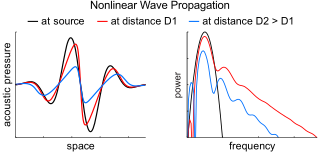
Nonlinear acoustics (NLA) is a branch of physics and acoustics dealing with sound waves of sufficiently large amplitudes. Large amplitudes require using full systems of governing equations of fluid dynamics and elasticity. These equations are generally nonlinear, and their traditional linearization is no longer possible. The solutions of these equations show that, due to the effects of nonlinearity, sound waves are being distorted as they travel.
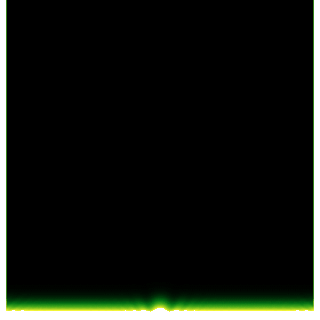
A Bessel beam is a wave whose amplitude is described by a Bessel function of the first kind. Electromagnetic, acoustic, gravitational, and matter waves can all be in the form of Bessel beams. A true Bessel beam is non-diffractive. This means that as it propagates, it does not diffract and spread out; this is in contrast to the usual behavior of light, which spreads out after being focused down to a small spot. Bessel beams are also self-healing, meaning that the beam can be partially obstructed at one point, but will re-form at a point further down the beam axis.

Underwater acoustics is the study of the propagation of sound in water and the interaction of the mechanical waves that constitute sound with the water, its contents and its boundaries. The water may be in the ocean, a lake, a river or a tank. Typical frequencies associated with underwater acoustics are between 10 Hz and 1 MHz. The propagation of sound in the ocean at frequencies lower than 10 Hz is usually not possible without penetrating deep into the seabed, whereas frequencies above 1 MHz are rarely used because they are absorbed very quickly. Underwater acoustics is sometimes known as hydroacoustics.
The ASA Silver Medal is an award presented by the Acoustical Society of America to individuals, without age limitation, for contributions to the advancement of science, engineering, or human welfare through the application of acoustic principles or through research accomplishments in acoustics. The medal is awarded in a number of categories depending on the technical committee responsible for making the nomination.
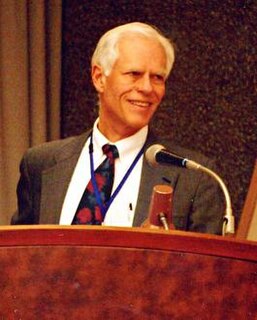
William M. Hartmann is a noted physicist, psychoacoustician, author, and former president of the Acoustical Society of America. His major contributions in psychoacoustics are in pitch perception, binaural hearing, and sound localization. Working with junior colleagues, he discovered several major pitch effects: the binaural edge pitch, the binaural coherence edge pitch, the pitch shifts of mistuned harmonics, and the harmonic unmasking effect. His textbook, Signals, Sound and Sensation, is widely used in courses on psychoacoustics. He is currently a professor of physics at Michigan State University.
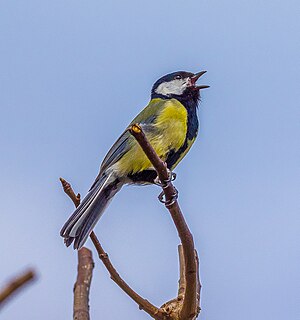
The Lombard effect or Lombard reflex is the involuntary tendency of speakers to increase their vocal effort when speaking in loud noise to enhance the audibility of their voice. This change includes not only loudness but also other acoustic features such as pitch, rate, and duration of syllables. This compensation effect maintains the auditory signal-to-noise ratio of the speaker's spoken words.
A Fessenden oscillator is an electro-acoustic transducer invented by Reginald Fessenden, with development starting in 1912 at the Submarine Signal Company of Boston. It was the first successful acoustical echo ranging device. Similar in operating principle to a dynamic voice coil loudspeaker, it was an early kind of transducer, capable of creating underwater sounds and of picking up their echoes.
Acoustic attenuation is a measure of the energy loss of sound propagation in media. Most media have viscosity, and are therefore not ideal media. When sound propagates in such media, there is always thermal consumption of energy caused by viscosity. This effect can be quantified through the Stokes's law of sound attenuation. Sound attenuation may also be a result of heat conductivity in the media as has been shown by G. Kirchhoff in 1868. The Stokes-Kirchhoff attenuation formula takes into account both viscosity and thermal conductivity effects.
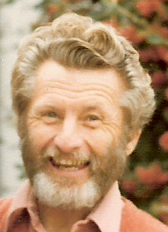
Gordon Eugene Martin is an American physicist and author in the field of piezoelectric materials for underwater sound transducers. He wrote early computer software automating iterative evaluation of direct computer models through a Jacobian matrix of complex numbers. His software enabled the Navy Electronics Laboratory (NEL) to accelerate design of sonar arrays for tracking Soviet Navy submarines during the Cold War.

Timothy Grant Leighton is the Professor of Ultrasonics and Underwater Acoustics at the University of Southampton. He is the inventor-in-chief of Sloan Water Technology Ltd., a company founded around his inventions. He is an academician of three national academies. Trained in physics and theoretical physics, he works across physical, medical, biological, social and ocean sciences, fluid dynamics and engineering. He joined the Institute of Sound and Vibration Research (ISVR) at the University of Southampton in 1992 as a lecturer in underwater acoustics, and completed the monograph The Acoustic Bubble in the same year. He was awarded a personal chair at the age of 35 and has authored over 400 publications.
Binaural unmasking is phenomenon of auditory perception discovered by Ira Hirsh. In binaural unmasking, the brain combines information from the two ears in order to improve signal detection and identification in noise. The phenomenon is most commonly observed when there is a difference between the interaural phase of the signal and the interaural phase of the noise. When such a difference is present there is an improvement in masking threshold compared to a reference situation in which the interaural phases are the same, or when the stimulus has been presented monaurally. Those two cases usually give very similar thresholds. The size of the improvement is known as the "binaural masking level difference" (BMLD), or simply as the "masking level difference".
Ma Dayou or Dah-You Maa was a Chinese acoustical physicist, specializing in various aspects of acoustics, especially sound generation, transmission and absorption. Academician of Chinese Academy of Sciences (CAS), Ma was a research professor at Institute of Acoustics of CAS; Chairman of Chinese National Acoustics Standardization Technical Committee; and Editor-in-Chief of Chinese Journal of Acoustics.
Evgenia Andreevna Zabolotskaya (1935–2020) was a Russian-American physicist known for her contributions to nonlinear acoustics. the Khokhlov–Zabolotskaya equation and Khokhlov–Zabolotskaya–Kuznetsov equation in nonlinear acoustics are named in part for her.
References
- ↑ Beyer, Robert T. "Preface to the Original Edition". Nonlinear Acoustics.
- 1 2 Novikov, B. K.; Rudenko, O. V.; Timoshenko, V. I. (1987). Nonlinear Underwater Acoustics. Translated by Robert T. Beyer. American Institute of Physics. ISBN 9780883185223. OCLC 16240349.
- ↑ Trenchard, Stephen E.; Coppens, Alan B. (1980). "Experimental study of a saturated parametric array in air". The Journal of the Acoustical Society of America. 68 (4): 1214–1216. Bibcode:1980ASAJ...68.1214T. doi:10.1121/1.384959.
- ↑ Johnson, P. A.; Meegan, G. D.; McCall, K.; Bonner, B. P.; Shankland, T. J. (1992). "Finite amplitude wave studies in earth materials". The Journal of the Acoustical Society of America. 91 (4): 2350. Bibcode:1992ASAJ...91.2350J. doi:10.1121/1.403453.
- ↑ Parametric Beam Formation in Rock
- ↑ Professor Peter Westervelt and the parametric array
- ↑ Institute of Acoustics - Medals & Awards Programme Archived 2009-06-28 at the Wayback Machine
- ↑ Muir 1976, p. 554.
- 1 2 Albers 1972
- ↑ Westervelt 1963
- ↑ Roy & Wu 1993
- ↑ Beyer 1974
- ↑ Bellin & Beyer 1960
- ↑ Westervelt, Peter J. (1975). "The status and future of nonlinear acoustics". The Journal of the Acoustical Society of America. 57 (6): 1352–1356. Bibcode:1975ASAJ...57.1352W. doi:10.1121/1.380612.
- ↑ Sources of Difference Frequency Sound in a Dual-Frequency Imaging System with Implications for Monitoring Thermal Surgery [ permanent dead link ]
- ↑ Moffett & Mellen 1977
- ↑ Moffett & Mellen 1976
- ↑ "Texas KZK Time Domain Code".
- ↑ Woodsum & Westervelt 1981
- ↑ Woodsum 2006
- ↑ Cabot & Putterman 1981
- ↑ Kaduchak, Gregory; Sinha, Dipen N.; Lizon, David C.; Kelecher, Michael J. (2000). "A non-contact technique for evaluation of elastic structures at large stand-off distances: applications to classification of fluids in steel vessels". Ultrasonics. 37 (8): 531–536. doi:10.1016/S0041-624X(99)00109-2. PMID 11243456.
- ↑ Naugolnykh, Konstantin A.; Esipov, Igor B. (1995). "Remote ocean sensing by parametric array". The Journal of the Acoustical Society of America. 98 (5): 2915. Bibcode:1995ASAJ...98.2915N. doi: 10.1121/1.414208 .
- ↑ Konofagou, Elisa; Thierman, Jonathan; Hynynen, Kullervo (2001). "A focused ultrasound method for simultaneous diagnostic and therapeutic applications—a simulation study". Physics in Medicine and Biology. 46 (11): 2967–2984. Bibcode:2001PMB....46.2967K. doi:10.1088/0031-9155/46/11/314. PMID 11720358. S2CID 2036873.
- ↑ Zhang, Dong; Chen, Xi; Xiu-fen, Gong (2001). "Acoustic nonlinearity parameter tomography for biological tissues via parametric array from a circular piston source—Theoretical analysis and computer simulations". The Journal of the Acoustical Society of America. 109 (3): 1219–1225. Bibcode:2001ASAJ..109.1219Z. doi:10.1121/1.1344160. PMID 11303935.
- ↑ Muir, T. G.; Wyber, R. J. (1984). "High‐resolution seismic profiling with a low‐frequency parametric array". The Journal of the Acoustical Society of America. 76 (S1): S78. Bibcode:1984ASAJ...76...78M. doi:10.1121/1.2022023.
- ↑ "Archived copy". Archived from the original on 2007-03-09. Retrieved 2006-12-05.
{{cite web}}: CS1 maint: archived copy as title (link) - ↑ n:Elwood Norris receives 2005 Lemelson-MIT Prize for invention.
- ↑ Reeves, C.; Goldsberry, T.; Rohde, D. (1979). "Experiments with a large aperture parametric acoustic receiving array". ICASSP '79. IEEE International Conference on Acoustics, Speech, and Signal Processing. Vol. 4. pp. 616–619. doi:10.1109/ICASSP.1979.1170632.